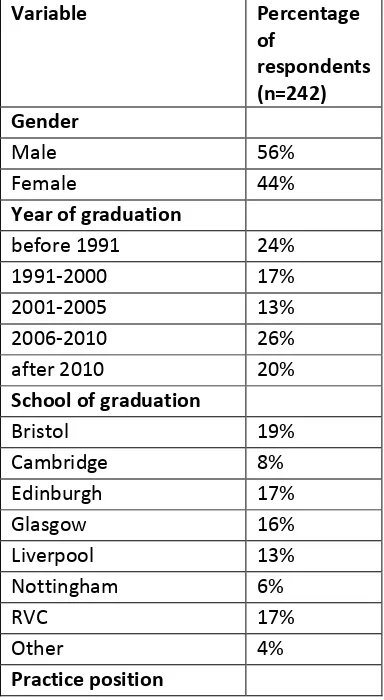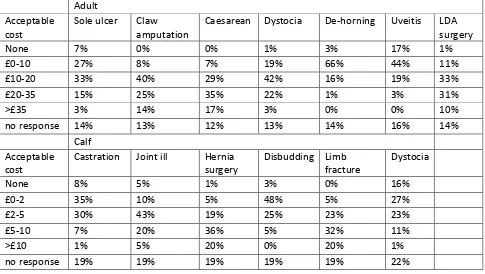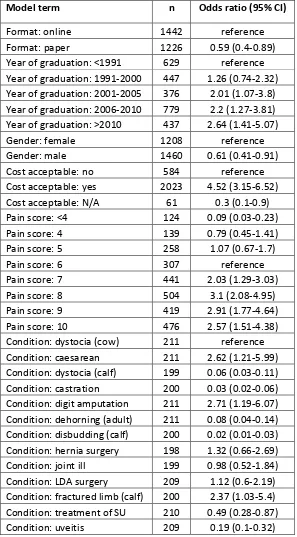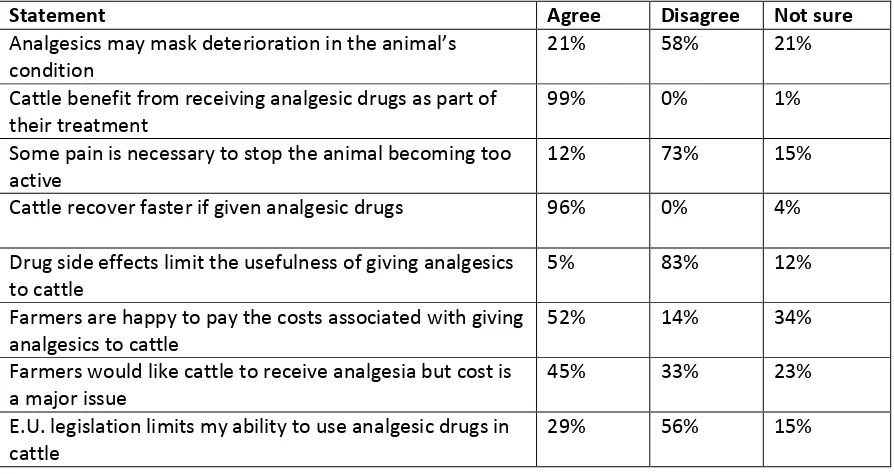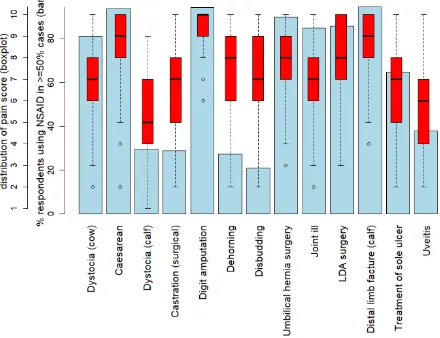Clinician attitudes to pain and use of
analgesia in cattle – Where are we
10-years on?
Remnant, J.G.1, Tremlett, A.2, Huxley, J.N.1 and Hudson, C.D.1
1 School of Veterinary Medicine and Science, University of Nottingham, Sutton Bonington,
Leicestershire LE12 5RD
2Goulburn Valley Equine Hospital, 905 Goulburn Valley Highway, Congupna,Victoria 3633, Australia
ABSTRACT
Pain in cattle can arise though disease or injury or may result from veterinary or husbandry procedures. Controlling pain is important to safeguard animal welfare. Previous studies indicated that the use of analgesics in cattle has lagged behind use in companion animals. Over the last decade, more analgesic products have become available for use in cattle and there have been increased efforts to communicate the importance and benefits of analgesia. A questionnaire (based on that used in a similar study published in 2006) was sent to UK cattle practitioners asking them to score pain severity for several conditions of cattle and asking about their attitudes towards and use of analgesic medicines. A total of 242 surveys were returned. Male clinicians and those graduating before 1990 scored pain severity significantly lower and were significantly less likely to use non-steroidal anti-inflammatory drugs (NSAIDs). Generally, use of NSAIDs was more common for
conditions assigned higher pain scores. However, uptake of NSAID use was much lower for a number of routine procedures in calves than would be expected from the pain scores they were assigned. A need remains to increase use of analgesic products, especially NSAIDs in calves, in line with best practice recommendations.
INTRODUCTION
Painful conditions are frequently encountered in cattle, whether disease-associated or iatrogenic following veterinary or husbandry interventions. Pain responses have been demonstrated in cattle with various diseases including lameness (Whay and others 1997) and mastitis (Fitzpatrick and others 1998) and it is logical to assume that they occur for other common diseases and conditions. Pain has also been identified in cattle following veterinary or husbandry procedures including surgery (Walker and others 2011), castration (Robertson and others 1994) and disbudding (Graf and Senn 1999) and can arise as a result of inappropriate handling or management. Whilst prevention and avoidance is important, some degree of disease and the necessity of some husbandry
procedures currently remains unavoidable. Reducing the pain caused by these diseases and procedures is an important aspect of maintaining farm animal welfare.
Numerous analgesic and anaesthetic products are available and licensed for use in farm animals, including non-steroidal anti-inflammatory drugs (NSAIDs) and local anaesthetics. The reduction in pain associated with using these products during routine husbandry procedures is well documented (Heinrich and others 2010; Heinrich and others 2009; Stafford and Mellor 2011; Stafford and others 2002), and there is increasing evidence to support the benefits in painful diseases as well, including lameness (Thomas and others 2015), mastitis (Fitzpatrick and others 2013) and metritis (Pohl and others 2016).
Cattle are naturally stoical animals, and whilst there are a number of pain assessment tools available for research, the use of analgesics in cattle relies heavily on the recognition and perception of pain by both producers and prescribing veterinarians. A previous large-scale survey evaluating the attitudes of UK cattle practitioners to pain and the use of analgesics identified that pain scores for different conditions varied markedly between individuals, with significant effects of gender and decade of graduation (Huxley and Whay 2006). The authors suggested that more work was needed to disseminate up-to-date knowledge to cattle practitioners. A similar approach in New Zealand (Laven and others 2009) revealed similar findings.
exchange activities. The aim of this study was to assess whether perceptions of pain in cattle by cattle practitioners have changed in the intervening decade.
MATERIALS AND METHODS
Data was collected by questionnaire. The questionnaire was deliberately designed to be similar to that used by Huxley and Whay (2006) to allow comparisons to be made (see supplementary material). Paper copies of the questionnaire with a reply paid envelope were sent to 650 UK veterinary practices randomly selected from the mailing list of a pharmaceutical company (Boehringer Ingelheim). An electronic copy of the questionnaire was also created and distributed online using a web based system (SurveyMonkey Inc., California, USA, www.surveymonkey.com). Paper surveys were accompanied by a cover letter that also contained a link to the electronic survey and made it clear than multiple responses from a practice were allowed by either copying the paper version or by the electronic version. The survey was promoted with a letter in The Veterinary Record two weeks after being mailed out, emails promoting the survey were also circulated to members of the British Cattle Veterinary Association and around a network of independent farm animal practices (XLVets). These emails were sent approximately five and eight weeks after mailing the paper
questionnaire. A copy of the paper version is included in the Supplementary Material. The questionnaire consisted of six parts:
1. Part one collected demographic information including gender, year and place of graduation, level of qualification and practice details.
2. Part two asked respondents to list the analgesic agents used for cattle in their practice. 3. Part three reviewed the use of analgesics in adult cattle, with factors affecting their use,
followed by a list of conditions and procedures with questions regarding the respondent's use of analgesia for these conditions. Participants were also asked to score the expected pain severity (in the absence of any analgesia or anaesthesia) on a ten-point scale and what they would consider an acceptable cost for analgesia for each condition/procedure.
4. Part four was similar to part three but related to calves
5. Part five gathered information about the participant’s opinions on analgesics by asking their agreement with a series of statements and whether their opinions had changed in the previous 5-10 years.
6. Part six asked about continuing education and where participants had gained their knowledge on pain in cattle.
Data from paper surveys was input into a spreadsheet (Microsoft Excel 2016; Microsoft Corp.) and merged with data from online respondents. Error checking and data audit was carried out at this stage. For pain score data, the distributions of scores across conditions and procedures were presented as boxplots. Pairwise associations between pain score assigned and various demographic factors were tested using Mann-Whitney U tests for factors with two categories, and Kruskal-Wallis tests for factors with more than two categories. As there were substantial correlations within some of these demographic factors (for example, the higher proportion of female graduates in later years), a multivariable linear regression model was constructed with pain score as the outcome variable, using a respondent-level random effect to account for repeated scores within individuals. The model was built using forward selection, and visual assessment of distribution of residuals and influence plots was used to assess model fit.
conditions and procedures. For NSAID use, the distribution of these responses was strongly bimodal, with respondents mostly giving values very close to either zero or 100% for a given condition. NSAID use was therefore recoded as a binary outcome (using 50% as the threshold percentage). This was compared graphically across conditions and procedures, and used as the outcome for a logistic regression model to investigate other factors associated with NSAID use. The model was built using forward selection, again using a respondent-level random effect to account for repeated responses within individual. Final parameter estimates were generated using a Markov Chain Monte Carlo procedure, and model fit checked using a Hosmer-Lemeshow test. Data analysis was carried out in R 3.2.5 (R Core Team 2013), with MLwiN 2.36 (Rasbash and others 2009) used for regression model building and parameter assessment.
RESULTS
Demographic data
[image:4.595.72.264.415.765.2]A total of 102 paper questionnaires were returned, of which five were mostly incomplete. The response rate for the paper questionnaire was 16% (102/650). A further 145 responses were received via the online survey, so a total of 242 questionnaires were analysed. It was not possible to calculate a response rate for the online survey because the extent of distribution was unknown. Where questions were omitted or filled in illegibly, those questions were not analysed for that respondent, but the remainder of the questionnaire was included in other analyses where possible. Demographic data is shown in Table 1.
Table 1: Demographic data for respondents to a survey investigating attitudes to pain and the use of analgesia in cattle
Variable Percentage
of
respondents (n=242) Gender
Male 56%
Female 44%
Year of graduation
before 1991 24% 1991-2000 17% 2001-2005 13% 2006-2010 26% after 2010 20%
School of graduation
Bristol 19%
Cambridge 8%
Edinburgh 17%
Glasgow 16%
Liverpool 13% Nottingham 6%
RVC 17%
Other 4%
Employees 61% Employers 37%
Additional qualifications
Certificate level 11% Diploma-level 7%
Proportion of time spent treating cattle
Median time 70% Lower and upper
quartile
40-90%
Pain assessment
The distributions of estimated pain score across conditions and procedures are shown in Figure 1. Ranked by median pain score, neck calluses and hock hair loss were considered the least painful (median score 3), whilst digit amputation was considered the most painful (median score 10). For most conditions, the inter-quartile range of scores covers 2-3 points on the scale, whilst most of the full range of scores was used for almost all conditions. For example, 21 out of the 27 conditions and procedures covered had some respondents scoring them at score 2 or 1. Conversely, whilst hock hair loss was generally considered the joint least painful condition (based on median score), eight
respondents scored this at 8 or higher.
For 12 of the 27 conditions and procedures, the median score had increased compared to a previous survey using the same questions and structure (Huxley and Whay 2006). The median score assigned to surgery to correct a left displaced abomasum was the only one to have decreased since the earlier work. In all of these cases, the change in median score was by one point.
Aggregating scores across all conditions, male respondents assigned lower scores (median score difference of one point, p<0.01). Initially, significant differences were also observed between year and school of graduation, pre-university background (all p<0.01) and attainment of a clinical postgraduate qualification (p<0.05). Only gender of respondent and year of graduation remained in a multivariable linear model with pain score as the outcome, suggesting that the other pairwise associations were mostly confounded by gender and year of graduation. Female gender was associated with an increase of 0.36 in pain score. Year of graduation prior to 1990 was associated with a decrease of 0.48 in pain score compared to graduates since 2010, but graduation between these years was not significantly different to either group.
Attributing acceptable cost of analgesia
respondents for caesarean section, surgical castration, digit amputation, calf disbudding, umbilical hernia surgery, joint ill and distal limb fracture). However, there were a small number of conditions where the estimated cost more commonly fell above the respondent’s acceptable range (with 80% of respondents selecting an acceptable cost below the estimated true cost for adult dehorning, 72% for uveitis and 40% for treatment of a sole ulcer).
Table 2: Acceptable costs of analgesia for various procedures and conditions of adult cattle and calves given by respondents in a survey investigating attitudes to pain and the use of analgesia in cattle (n=242)
Adult Acceptable
cost
Sole ulcer Claw amputation
Caesarean Dystocia De-horning Uveitis LDA surgery
None 7% 0% 0% 1% 3% 17% 1%
£0-10 27% 8% 7% 19% 66% 44% 11%
£10-20 33% 40% 29% 42% 16% 19% 33%
£20-35 15% 25% 35% 22% 1% 3% 31%
>£35 3% 14% 17% 3% 0% 0% 10%
no response 14% 13% 12% 13% 14% 16% 14% Calf
Acceptable cost
Castration Joint ill Hernia surgery
Disbudding Limb fracture
Dystocia
None 8% 5% 1% 3% 0% 16%
£0-2 35% 10% 5% 48% 5% 27%
£2-5 30% 43% 19% 25% 23% 23%
£5-10 7% 20% 36% 5% 32% 11%
>£10 1% 5% 20% 0% 20% 1%
no response 19% 19% 19% 19% 19% 22%
Use of analgesia
The two main methods of providing analgesia (NSAIDs and local anaesthesia) were considered separately. Figure 2 shows the proportion of respondents using NSAID in at least 50% of cases across a range of conditions and procedures, plotted alongside the distribution of pain scores for the same conditions and procedures. Generally, it is clear that the conditions scored as more painful tended to receive NSAID treatment more commonly. However, a number of conditions were associated with a much lower degree of NSAID use, despite being assigned similar pain scores to conditions much more likely to receive NSAID. This was particularly marked for disbudding and surgical castration in calves and dehorning in adult cattle, with only 20-30% of respondents using NSAID in at least half of the cases they saw, despite all three having median pain scores of 7-8.
Table 3: Parameter estimates for a logistic regression model with the (binary) outcome representing whether a respondent used NSAID in more than 50% of cases of a particular condition or procedure in a survey investigating attitudes to pain and use of analgesia in cattle. 95% CI = 95% Bayesian credible interval.
Model term n Odds ratio (95% CI)
Format: online 1442 reference Format: paper 1226 0.59 (0.4-0.89) Year of graduation: <1991 629 reference Year of graduation: 1991-2000 447 1.26 (0.74-2.32) Year of graduation: 2001-2005 376 2.01 (1.07-3.8) Year of graduation: 2006-2010 779 2.2 (1.27-3.81) Year of graduation: >2010 437 2.64 (1.41-5.07) Gender: female 1208 reference Gender: male 1460 0.61 (0.41-0.91) Cost acceptable: no 584 reference Cost acceptable: yes 2023 4.52 (3.15-6.52) Cost acceptable: N/A 61 0.3 (0.1-0.9) Pain score: <4 124 0.09 (0.03-0.23) Pain score: 4 139 0.79 (0.45-1.41) Pain score: 5 258 1.07 (0.67-1.7) Pain score: 6 307 reference Pain score: 7 441 2.03 (1.29-3.03) Pain score: 8 504 3.1 (2.08-4.95) Pain score: 9 419 2.91 (1.77-4.64) Pain score: 10 476 2.57 (1.51-4.38) Condition: dystocia (cow) 211 reference Condition: caesarean 211 2.62 (1.21-5.99) Condition: dystocia (calf) 199 0.06 (0.03-0.11) Condition: castration 200 0.03 (0.02-0.06) Condition: digit amputation 211 2.71 (1.19-6.07) Condition: dehorning (adult) 211 0.08 (0.04-0.14) Condition: disbudding (calf) 200 0.02 (0.01-0.03) Condition: hernia surgery 198 1.32 (0.66-2.69) Condition: joint ill 199 0.98 (0.52-1.84) Condition: LDA surgery 209 1.12 (0.6-2.19) Condition: fractured limb (calf) 200 2.37 (1.03-5.4) Condition: treatment of SU 210 0.49 (0.28-0.87) Condition: uveitis 209 0.19 (0.1-0.32)
marked for disbudding, castration and dystocia in calves, and dehorning in adult cattle, all of which were associated with much lower levels of NSAID use. This effectively demonstrates that the “decoupling” of pain score from NSAID use across these conditions highlighted in Figure 2 is a statistically significant effect, and that it persists when other potential confounding variables have been accounted for.
The vast majority of respondents used local anaesthesia for all of the surgical procedures. Over 95% of respondents reported that they used local anaesthesia in all cases for caesarean sections, digit amputation and dehorning adult animals, and between 90 and 95% of respondents used local anaesthesia for all left displaced abomasum surgery and calf disbudding. Two thirds of respondents (67%) used local anaesthesia for all calf castration.
Opinions regarding analgesia and pain
Just under 70% of respondents (142 of 203) felt that their knowledge of this area was adequate. Two thirds of respondents (138 of 209) stated that their use of analgesia had increased in the last five to ten years. Where use had increased, changes in farmer attitude were cited as the most common reasons for change (mentioned by 77% of those reporting increased use, n=106/138). Changes in respondent perception of pain in cattle, new scientific evidence and decreasing medicine costs were the next most common reason (59%, 56% and 43%; n=82, 78 and 59/138 respectively). Influence of colleagues (35%, n=48/138) and practice policy (28%, n=38/138) were less commonly mentioned. Further responses to the questions regarding opinions on analgesia and pain in cattle are
[image:8.595.73.520.438.675.2]summarised in Table 4.
Table 4: Summary of responses to questions regarding survey respondents’ opinions around analgesia and pain management in cattle (n=199, respondents not answering these questions excluded).
Statement Agree Disagree Not sure
Analgesics may mask deterioration in the animal’s condition
21% 58% 21%
Cattle benefit from receiving analgesic drugs as part of their treatment
99% 0% 1%
Some pain is necessary to stop the animal becoming too active
12% 73% 15%
Cattle recover faster if given analgesic drugs 96% 0% 4%
Drug side effects limit the usefulness of giving analgesics to cattle
5% 83% 12%
Farmers are happy to pay the costs associated with giving analgesics to cattle
52% 14% 34%
Farmers would like cattle to receive analgesia but cost is a major issue
45% 33% 23%
E.U. legislation limits my ability to use analgesic drugs in cattle
29% 56% 15%
DISCUSSION
The results of the current study suggest that perception of pain in cattle by cattle practitioners has increased since the work of Huxley and Whay (2006), with over 40% of the procedures and
pain severity scores there is still a large degree of variation between practitioners. Some of this variation is explained by the gender of the participant, with male practitioners on average giving lower pain severity scores than female practitioners. This is consistent with previous findings in the UK (Huxley and Whay 2006), from overseas (Becker and others 2013; Kielland and others 2009; Lorena and others 2013) and in small animal practice (Williams and others 2005). Year of graduation also had a significant association with pain score, with respondents graduating before 1990 giving significantly lower pain scores than those graduating after 2010. This is also consistent with the previous findings (Huxley and Whay 2006) and findings outside the UK (Becker and others 2013; Raekallio and others 2003). This is one of the first studies in this area to use a multivariable
technique to confirm that the associations with gender and year of graduation exist independently and are not confounded by the changing gender balance of veterinary graduates over time. This may reflect advances in our understanding of pain and pain management as well as increased importance placed on pain recognition and management in undergraduate veterinary curricula. Variables that initially appeared to be associated with pain scores, such as school of graduation, pre-university background and post-graduate qualifications were not retained in the multivariable model
suggesting that the apparent associations initially identified were confounded by correlations with gender and year of graduation. Other factors not measured here, such as empathy of the
respondents, have also been shown to affect participants’ perception of pain in cattle, although empathy is also associated with gender and pain perception tends to be strongly correlated with empathy (Norring and others 2014). The apparent increased perception of pain by more recent graduates is encouraging and suggests that things are changing, however another possible explanation is that veterinary surgeons’ sensitivity to signs of pain declines with experience. It has been shown that experienced human acupuncturists’ brains react differently to control groups when viewing videos of needles been pushed in to patients (Cheng and others 2007).
many would find outdated and even unacceptable. Industry led initiatives and codes of practice provide an opportunity to encourage best practice and respond to developments in a more dynamic way (Anon 2016).
As the existing barriers to NSAID use are reduced it is important that new barriers are not created. Informal feedback from producers suggests that there may be two challenges with terminology in this area (at least in English – the same may not be true in other languages). Firstly “NSAIDs”, “non-steroidals” and “anti-inflammatories” are more medical terms which can confuse producers and complicate the message. “Pain killer” is a more widely understood and user friendly term accepting that it is imprecise and doesn’t acknowledge the other important pharmacological actions of this group of drugs. Secondly the drive to rationalise antibiotic administration in food animals, because of the concerns over antimicrobial resistance, appears to be leading to fear and confusion amongst some producers over all injectable products. This is particularly the case for NSAIDs because of the incorrectly perceived similarities/associations between “anti-biotics” and “anti-inflammatories”. It is imperative that the drive to reduce, refine and replace antibiotic usage does not lead to a reduction in anti-inflammatory administration. It is also important to ensure that public perception of the use of NSAIDs and other analgesics is considered and that the benefits of analgesics are effectively communicated to all stakeholders in the supply chain.
If recognition, perception and awareness of pain is becoming less of a barrier to the use of NSAIDs then there is a need to explore further barriers. Cost is often identified as a barrier to analgesic use, in the earlier work of Whay and Huxley (2005) over 65% of respondents agreed that “farmers would like cattle to receive analgesia but cost is a major issue”; in the current study this has reduced to 45%. Similarly, the percentage of respondents agreeing that “farmers are happy to pay the costs involved with giving analgesics to cattle” has increased from 36% to 52% between the two studies. This suggests that, whilst cost is still an issue, attitudes in this area are changing. In this study, procedures such as disbudding and castrating calves were allocated the lowest acceptable costs of analgesia by respondents. However, the estimated cost of providing NSAID analgesia for these procedures were still within the acceptable range given for disbudding for over 90% of respondents. This is a positive sign and may reflect the decreasing price and increasing availability of NSAIDs licensed for use in cattle in the UK. Interestingly, in a study of Danish veterinarians and dairy farmers, whilst less farmers than veterinarians agreed that using analgesics makes economic sense (64% and 85.1% respectively) only a minority of both groups (27% and 26.1%) agreed that they would like to use analgesics for cows but that price was a major problem (Thomsen and others 2012). This suggests that although they may not see a cost-benefit, farmers are still willing to use analgesia in their animals. Winder and others (2016) showed that veterinarians were far more likely than producers to cite cost as a reason not to use NSAIDs for disbudding. This is similar to findings relating to the control of mastitis where non-monetary factors such as taking pride in healthy animals were equally important as economic drivers (Valeeva and others 2007).
Similarly there is risk of respondent answering in line with expectations. Both these potential biases would likely result in an overestimation of analgesic use.
CONCLUSION
Over the last decade, there has been a promising increase in the use of analgesics by UK veterinary surgeons treating painful conditions or carrying out painful procedures in cattle. This corresponds to an associated increased in the pain severity scores given for many of these procedures. There is a concerning mismatch between frequency of analgesic use (at least in terms of NSAID) and perceived severity of pain in routine calf procedures such as disbudding and castration, an area which clearly warrants further work.
ACKNOWLEDGEMENTS
The authors would like to acknowledge the financial support of Boehringer Ingelheim for the printing and distribution of the paper questionnaires. The time and support of all the clinicians who
completed the survey is also gratefully acknowledged.
REFERENCES
ANON (2016) Industry ‘disappointed’ as Defra backtracks on welfare
codes. Veterinary Record 178, 383-383
BECKER, J., REIST, M., FRIEDLI, K., STRABEL, D., WÜTHRICH, M. &
STEINER, A. (2013) Current attitudes of bovine practitioners,
claw-trimmers and farmers in Switzerland to pain and painful interventions
in the feet in dairy cattle. The veterinary journal 196, 467-476
CHENG, Y., LIN, C.-P., LIU, H.-L., HSU, Y.-Y., LIM, K.-E., HUNG, D. &
DECETY, J. (2007) Expertise Modulates the Perception of Pain in
Others. Current Biology 17, 1708-1713
COETZEE, J. F. (2011) A review of pain assessment techniques and
pharmacological approaches to pain relief after bovine castration:
Practical implications for cattle production within the United States.
Applied Animal Behaviour Science 135, 192-213
COETZEE, J. F. (2013) Assessment and Management of Pain
Associated with Castration in Cattle. Veterinary Clinics of North
America: Food Animal Practice 29, 75-101
FISHER, A., CROWE, M., ALONSO DE LA VARGA, M. & ENRIGHT, W.
(1996) Effect of castration method and the provision of local
meloxicam on pain sensitivity, rumination time, and clinical signs in
dairy cows with endotoxin-induced clinical mastitis. Journal of dairy
science 96, 2847-2856
FITZPATRICK, J. L., YOUNG, F. J., ECKERSALL, D., LOGUE, D., KNIGHT, C.
& NOLAN, A. (1998) Recognising and controlling pain and
inflammation in mastitis. In Proc of the British Mastitis Conference. pp
36-44
GRAF, B. & SENN, M. (1999) Behavioural and physiological responses
of calves to dehorning by heat cauterization with or without local
anaesthesia. Applied Animal Behaviour Science 62, 153-171
HEINRICH, A., DUFFIELD, T. F., LISSEMORE, K. D. & MILLMAN, S. T.
(2010) The effect of meloxicam on behavior and pain sensitivity of
dairy calves following cautery dehorning with a local anesthetic.
Journal of dairy science 93, 2450-2457
HEINRICH, A., DUFFIELD, T. F., LISSEMORE, K. D., SQUIRES, E. J. &
MILLMAN, S. T. (2009) The impact of meloxicam on postsurgical stress
associated with cautery dehorning. Journal of dairy science 92,
540-547
HUDSON, C., WHAY, H. & HUXLEY, J. (2008) Recognition and
management of pain in cattle. In Practice 30, 126-134
HUXLEY, J. N. & WHAY, H. R. (2006) Current attitudes of cattle
practitioners to pain and the use of analgesics in cattle. Veterinary
Record 159, 662-668
KIELLAND, C., SKJERVE, E. & ZANELLA, A. J. (2009) Attitudes of
veterinary students to pain in cattle. Veterinary Record 165, 254-258
LAVEN, R. A., HUXLEY, J. N., WHAY, H. R. & STAFFORD, K. J. (2009)
Results of a survey of attitudes of dairy veterinarians in New Zealand
regarding painful procedures and conditions in cattle. New Zealand
Veterinary Journal 57, 215-220
NORRING, M., WIKMAN, I., HOKKANEN, A.-H., KUJALA, M. V. &
HÄNNINEN, L. (2014) Empathic veterinarians score cattle pain higher.
The veterinary journal 200, 186-190
POHL, A., BERTULAT, S., BORCHARDT, S., BURFEIND, O. &
HEUWIESER, W. (2016) Randomized, controlled clinical trial on the
efficacy of nonsteroidal antiinflammatory drugs for the treatment of
acute puerperal metritis in dairy cows. Journal of dairy science 99,
8241-8249
R CORE TEAM (2013) R: A language and environment for statistical
computing. Vienna, Austria, R Foundation for Statistical Computing
RAEKALLIO, M., HEINONEN, K., KUUSSAARI, J. & VAINIO, O. (2003)
Pain alleviation in animals: attitudes and practices of Finnish
veterinarians. The veterinary journal 165, 131-135
RASBASH, J., CHARLTON, C., BROWNE, W. J., HEALY, M. & CAMERON,
B. (2009) MLwiN Version 2.1. Centre for Multilevel Modelling,
University of Bristol, Bristol, UK
ROBERTSON, I., KENT, J. & MOLONY, V. (1994) Effect of different
methods of castration on behaviour and plasma cortisol in calves of
three ages. Research in Veterinary Science 56, 8-17
STAFFORD, K. J. & MELLOR, D. J. (2011) Addressing the pain
associated with disbudding and dehorning in cattle. Applied Animal
Behaviour Science 135, 226-231
STAFFORD, K. J., MELLOR, D. J., TODD, S. E., BRUCE, R. A. & WARD, R.
N. (2002) Effects of local anaesthesia or local anaesthesia plus a
non-steroidal anti-inflammatory drug on the acute cortisol response of
calves to five different methods of castration. Research in Veterinary
Science 73, 61-70
STOCK, M. L., BALDRIDGE, S. L., GRIFFIN, D. & COETZEE, J. F. (2013)
Bovine Dehorning: Assessing Pain and Providing Analgesic
Management. Veterinary Clinics of North America: Food Animal
Practice 29, 103-133
in a randomized controlled trial. Journal of dairy science 98,
4477-4486
THOMSEN, P. T., ANNEBERG, I. & HERSKIN, M. S. (2012) Differences
in attitudes of farmers and veterinarians towards pain in dairy cows.
The veterinary journal 194, 94-97
VALEEVA, N. I., LAM, T. J. G. M. & HOGEVEEN, H. (2007) Motivation of
Dairy Farmers to Improve Mastitis Management. Journal of dairy
science 90, 4466-4477
WALKER, K. A., DUFFIELD, T. F. & WEARY, D. M. (2011) Identifying and
preventing pain during and after surgery in farm animals. Applied
Animal Behaviour Science 135, 259-265
WHAY, H., WATERMAN, A. & WEBSTER, A. (1997) Associations
between locomotion, claw lesions andnociceptive threshold in dairy
heifers during the peri-partum period. The veterinary journal 154,
155-161
WHAY, H. R. & HUXLEY, J. N. (2005) Pain Relief in Cattle: A
Practitioners Perspective. Cattle Practice 13, 81-85
WILLIAMS, V. M., LASCELLES, B. D. & ROBSON, M. C. (2005) Current
attitudes to, and use of, peri-operative analgesia in dogs and cats by
veterinarians in New Zealand. N Z Vet J 53, 193-202
WINDER, C. B., LEBLANC, S. J., HALEY, D. B., LISSEMORE, K. D.,
Figure legends
Figure 1: Distribution of pain scores (where 1 represents no pain and 10 the worst pain imaginable)
assigned to various conditions and procedures. Boxes show the interquartile range (IQR) of scores for each condition, vertical black lines the median score and horizontal lines the range (where any scores lie outside the IQR by more than 1.5 times the size of the IQR, they are represented by points beyond the line). The colour of the IQR box denotes animal type (adult versus calf), and arrows show change in median score compared to a 2004 survey using the same questions (Huxley and Whay 2006), with the non-head-end of the arrow showing the 2004 median.
Figure 2: Proportion of respondents using NSAID treatment in more than 50% of cases across a
